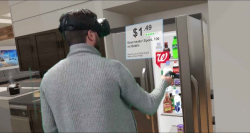E-COMMERCE
SECTION ONE
SECTION TWO
What Will V-Commerce Look Like?
By Gina Joseph
Virtual reality (VR) for retail is here. On the B2B level, it is already changing the way
manufacturers and retailers develop and execute in-store concepts. On the consumer-facing side,
it is still in the early stages. But similar to the groundbreaking qualities of the first iPhone, it’s on pace to quickly transform the way we shop.
In 2017, the retail industry is evolving at warp speed, with new technologies creating a digital, automated, and connected world where we use many different channels to make purchases. VR is on its way to becoming a permanent channel in that space. In fact, two of three consumers say they would be interested in virtual shopping, and 63 percent said they would expect VR and augmented reality (AR) technologies to change the way they shop, according to the WalkerSands Reinventing Retail 2015 report. But what will virtual commerce, or V-commerce, actually look like?
Experiential
One of the biggest advantages of VR when it comes to commerce will be its ability to fully immerse the shopper in a hyper-realistic setting, creating personalized experience that you can’t find in the real world.
For example, a shopper is inside a virtual apartment, where items like food, drinks and furniture are all for sale based on his recent purchases or loyalty card data. So instead of shopping in a traditional store, this experience would let the user shop based on a personalized room. He can pick up items out of the refrigerator, or even view different colors of the sofa to see how it would look in the space. Anything he wants to purchase he would simply drop into his virtual shopping cart.
Realistic
Another option for V-commerce is to have it mimic real-life shopping. One of the problems facing online grocery shopping today is that scrolling through an endless, stagnate list of items grouped by category can be time consuming—and it doesn’t offer the details you can see when shopping within a real grocery store. With virtual, you’ll be able to transport yourself in front of shelves just as if you were shopping in the real world, but without leaving your house.
Wine anyone? Picture a shopper in the wine section at a Walgreens. This ability to create a real-life shopping scenario marries brick and mortar stores with online shopping.
You might be able to pick up products, view the ingredients or nutritional information, and see them next to the competitors for a more realistic portrayal.
Entertaining
Shopping should be fun. And while nothing will replace a real world in-store experience, with V-commerce, we’ll be able to shop in places that don’t even exist in the physical world. Is it the middle of winter but you want to shop for patio furniture, from your own patio?
Want to buy rum for a party? Why not do it on a pirate ship in the middle of the ocean while shooting off cannons and petting a parrot?
Your purchases could be delivered to your door or picked up from a local retailer, or perhaps dropped from a drone within hours. The point is, VR technology is only getting better, and soon V-commerce will be an integrated part of the omni-shopper experience. Companies that embrace virtual today are showing they will be prepared for the truly unique future of retail.
Click here (or on the image at the top of the page) to view the short video, The Future of Commerce Mixed Reality.
Gina Joseph is the Communication Manager at InContext Solutions. For more information, visit www.incontextsolutions.com.
Click on the LinkedIn logo to join the new Shopper Technology Institute Discussion Group
SECTION THREE

